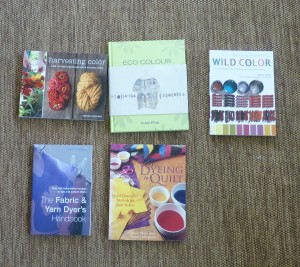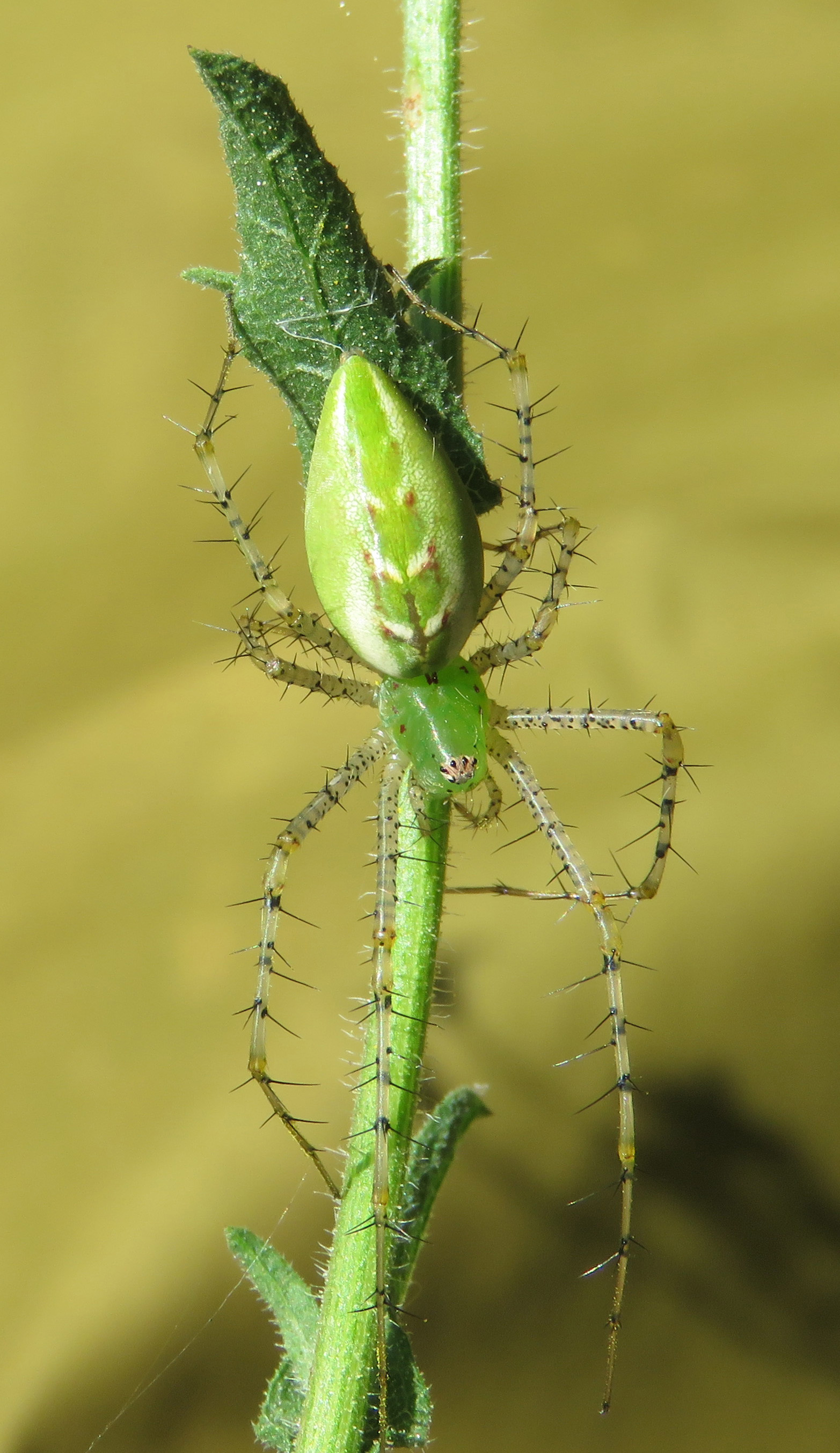Dye Days of Summer – Sunflowers
First the results –
And then the details.
My plan for the summer is to learn about natural dyes from the plants growing wild on the farm. To simplify my learning process, I decided to pick just one of these books to work through, and I chose Wild Color by Jenny Dean.
I also decided to limit myself to wool initially. I got Crown Colony 2-ply wool yarn from Dharma Trading.
I had some basic equipment – a big enamel pot, some small enamel bowls, gallon-size glass jars, and an electric hot plate. I bought a basic digital scale and a big candy thermometer, to keep records.
Day One – Prep Day
I wound the big skein into 25 little sample skeins of 10 grams each.
I prepared a jar of copper liquor and a jar of iron liquor, by putting scraps of each metal in a glass jar, and then covering with a mixture of water and vinegar, one part water to one part vinegar for the copper, two parts water to one part vinegar for the iron.

Copper scraps in vinegar and water on the left, iron scraps in vinegar and water on the right, about five days after initial preparation.
Evening One
I soaked the sample skeins overnight in distilled water – the water that drips from my window unit air conditioner into a plastic bucket.
Day Two – Mordant Day
Five skeins got no mordant at all, five got soaked in water from my pond (the thought was that it must be full of tannins), and fifteen got an alum mordant.
For the alum mordant, Dean recommends using 8% of the weight of the fiber in alum, and 7% of its weight in cream of tartar. She offers different ways of figuring how much to use with ounces, grams, dry weight, solution, milliliters, etc. After a lot of flipping back and forth in her book*, this is the method I ended up with:
Put 2 gallons of cool water into a pot dedicated to non-food use.
Boil about 5 cups of water separately.
In one measuring cup, mix 2 ounces of cream of tartar with 2 cups boiling water, until dissolved. (I used Adams brand.) When well-mixed, add 7 tablespoons (or a half cup, less one tablespoon) to the cool water in the big pot.
In another, mix 2 ounces alum with 2 cups boiling water. (I used McCormick regular household alum from the grocery store. The jar I bought had 1.9 ounces so I just used the whole thing.) When dissolved, add one-half cup to the cool water in the big pot. Stir everything well.
Remove the sample skeins from the water they have been soaking in, squeeze out excess water, and place into the pot. Bring pot to a simmer, simmer 1 hour. Turn off the heat and let the yarn cool in the solution overnight.
Day Three – The Fun Part! Sunflower Dye
Here are the sunflowers in the garden.
I had basically two ways of dyeing with them – traditional enamel pot and heat source, and solar jar.
Dye Pot – I weighed the sunflowers, covered them with water, heated to a simmer for an hour (without adding any yarn), and cooled overnight.
Solar Jar – I weighed the sunflowers, both fresh and spent blooms, and put them in a covered glass jar. Dean talks about using a real solar cooker and a black pot, and tilting the reflector to catch the sunlight, but she lives in the UK. I live in Texas. I just poured boiling water over the sunflowers, enough to cover, added 30 grams of yarn, and let it sit outside in the afternoon sun.
Day Four – The Dyeing Continues
Dye Pot – I added 3 small skeins (30 grams) to the pot of the cooled dye, with the plant parts still in the bath, heated to a simmer and let it simmer for one hour. I let it cool and pulled out skeins at different times.

Top two – alum mordant, sunflower dye, traditional method of heating. Bottom sample – dipped in the iron liquor for only five minutes!
You can see that whether I removed the skein after 4 hours or 24 hours, didn’t make much difference. I even left the bottom sample in for 48 hours, and it looked just the same as the other two, so I dipped it in some of the iron solution. After only five minutes, I had that dark gray!
The top sample shows the sunflower dye on unmordanted wool – a nice warm tan. The middle sample shows the results of the yarn just dipped into the iron liquor for 10 minutes. The bottom sample shows the combination of the two – unmordanted yarn soaked in sunflower dye for 3 hours, then dipped in iron for five minutes.
I will say that that yarn already feels a little brittle. We will have to see how it holds up.
So those are my results with the typical dye pot. I was much more excited about the results of my solar jar!
The top sample is one of my favorites. Greens are not easy to get! And I like this one.
The temperature in the jar only gets to about 120 degrees F, and I pulled this out after only four hours. It’s a little blotchy – this sample was in a weak alum bath because I had read directions wrong. I later added more alum to its mordant bath, but I think I will purposely do a very weak solution to see if that boosts the blue-green color in other batches.
The next two samples look pretty much the same. One of them was in a dye jar with the plant parts, and one of them was in a jar where the strained dye had sat for one week, but it didn’t seem to make any difference to the final color.
The last sample also had alum mordant, and sat in the solar jar for 48 hours. I dipped it in the copper liquor afterward. It does seem to have a little more blue cast, and the copper is supposed to make it more washfast, so we’ll see.
In this picture you see the original wool on top, then an unmordanted sample from the solar jar, a very light pinky-beige.
I got the darker pink sample by using pond water as a mordant. Dean is a big proponent of making tannin water with pounded acorns, rhubarb roots, etc. Well my pond has 50 years of fallen pine needles and acorns in it, so I thought it might be a good source of tannins. Its pH as about 6.4.
The bottom sample was just the same as the one above it, until I did the five minute iron dip on it, and got a good strong dark gray again.
So there you have it! I really love how I can just throw some plants and wool in a jar, and go off to do my regular work, and come back to find a pretty surprise. Lots of colors from one dye source, lots of ideas to follow up on. I will let all the samples sit for a few weeks before I try washing them, and then I will also do a lightfastness test.
*Fifteen small skeins equaled 150 grams of wool. According to Dean, you should use 8% of the weight of the wool in alum, and 7% in cream of tartar. That would equal 12 grams of alum, and 10.5 grams of cream of tartar. If they are in solution, that would be 24 teaspoons of alum solution and 21 teaspoons of cream of tartar.
























Pond water for the win! What interesting results! And those sunflowers are beautiful.
Yeah, it’s hard not to love something that you don’t have to measure or heat! I’m interested to see what it will do with the other plants I plan to try this summer.
Amazing results! Thank you for sharing the details. Be A Blessing because you’re Blessed. Mtetar
Awesome experiment. I once tried the cooked variety, just regular yellow sunflowers and hardly got a drab yellow.
Pingback: Dye Days of Summer – Pears | Deep in the Heart of Textiles
Pingback: Natural Dye Lightfastness Results | Deep in the Heart of Textiles
Pingback: Biodiversity…I Spy…Natural Dyes | Deep in the Heart of Textiles
Hiya, I’m planning on trying out your processes and there’s one part i’m a bit confused about: when you did the solar jar tests – the ones that came out more green-y colours – what does the ‘pre-M’ stand for. Did you add them to mordant again after you had already soaked them in mordant on day 2? Also, did you put the skeins in with the plant parts in the solar jars? Or try out a few with and a few without? Looks like you got some really varied results and had a lot of fun! I’ll be doing it in autumn in the UK so not sure it’ll work at all, but worth a try!
Hi, I am sorry I wasn’t more clear! I write M for any modification to the dye — either “pre” the dye bath, “with” the dye bath, or “post” the dye bath. (I guess it would make more sense if I wrote “pre-D”!)
When I first learned about natural dyeing, people taught me that you could mordant at any stage — when I started reading about it in more depth, I learned that if you put the mordant in with the dye, some of the molecules will just bond together without bothering to bond with the yarn. So now I mordant the skeins and let them dry, then put them in the jars with the plants parts and hot water. Sometimes I dip them in iron solution or ammonia afterward, so I would label those with a Post-M.
After lots of little experiments, the process I usually use is to mordant the skeins with alum one day, then a day or two later, throw them into a jar with plant parts and hot water and let them sit about 24 hours. Then pull them out and dip one into an afterbath of water with a tablespoon of ammonia, or into the jar of copper solution (copper scraps sitting in half vinegar and half water). If anything good happens, I might put some more in the afterbath.
For the sunflowers I used the flowers and seeds, not any leaves. They have faded over the years somewhat but you can still see soft colors. I got beautiful results on a sock yarn with Texas dandelion, but I am thinking any dandelion would be worth a try. However, those yarns just shredded after a few years — I don’t know if it was the nylon in the sock yarn, or moths, or if it was the dye itself.
If you look at the Jenny Dean book, she shows results from lots of plants and modifiers, but the key to her marking system is early on the book, on page 21 in the edition I have. I searched for it for a long time when I was using her book; that’s why I am passing on that info.
Such a long answer! I hope it helps and I hope you have fun with your experiments!